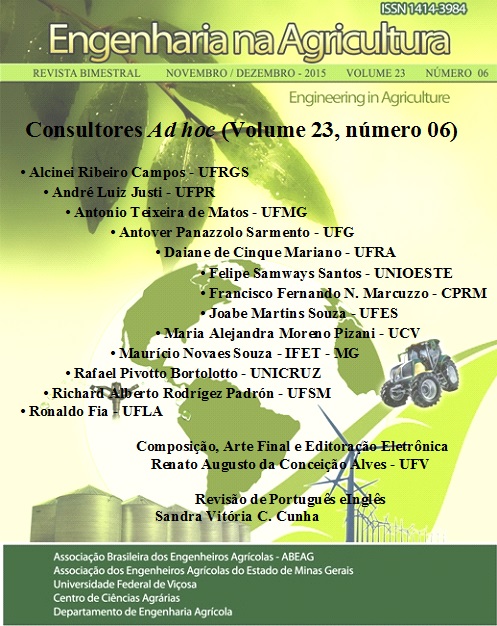IRRIGATION AND FERTIGATION PERFORMANCE EVALUATED BY STATISTICAL QUALITY CONTROL - DOI: 10.13083/1414-3984/reveng.v23n6p541-551
DOI:
https://doi.org/10.13083/reveng.v23i6.558Keywords:
Controle de qualidade, nitrogênio, aspersoresAbstract
The evaluation of an irrigation system can be made with use of uniformity of water distribution, whereas the Christiansen’s Coefficient of Uniformity (CCU) is the most used, since it is a source of evaluation of its proper functioning as well as a way to check its viability deployment and operation. This work has the objective to use the Statistical Quality Control (SQC), through the process capability index to evaluate the uniformity of water distribution from a conventional sprinkler irrigation system operating with water and performing fertigation. The tests were conducted at the Experimental Center of Agricultural Engineering - NEEA - belonging to the State University of West of Paraná - UNIOESTE - Campus Cascavel - Paraná, using 2 sprinklers Super10 model (NAANDAN), spaced 9 m apart and 18 collectors with a distance of 3 m. Climatic factors were monitored and collected at 10 min intervals by a wireless meteorological station (La Crosse) over 25 trials of 1 h each for irrigation and fertigation. For irrigation trials, an average CCU of 79.72% was found and the wind average speed was 1.85 m s-1and for fertigation, the CCU was 77.14% with an average wind speed of 1.50 m s-1. The upper and lower control limits were calculated for the quality control charts and process capability index for the uniformity coefficients. Results showed that the Statistical Quality Control is a powerful auxiliary tool forclassifying irrigation systems in the pursuit of optimization of water use.Downloads
Downloads
Published
How to Cite
Issue
Section
License
Authors who publish with this journal agree to the following terms:
The author(s) authorize(s) the publication of the text in the journal;
The author(s) ensure(s) that the contribution is original and unpublished and that it is not in the process of evaluation by another journal;
The journal is not responsible for the views, ideas and concepts presented in articles, and these are the sole responsibility of the author(s);
The publishers reserve the right to make textual adjustments and adapt texts to meet with publication standards.
From submission, the author is fully conceding the paper's patrimonial rights to the publication, but retaining the owner of its moral rights (authorship and paper's identification) according to Creative Commons Attribution-Noncommercial.








 Licensed by
Licensed by 